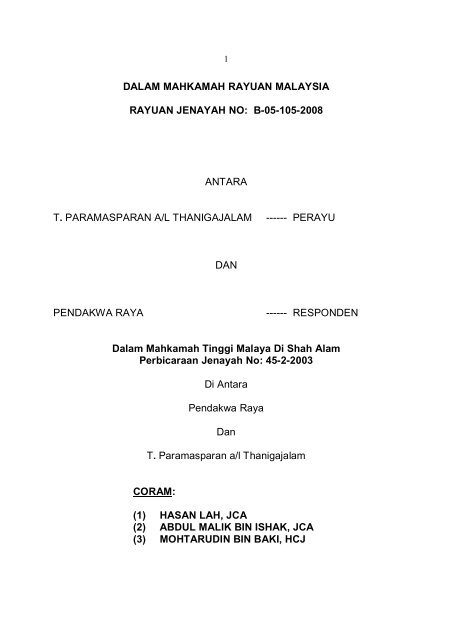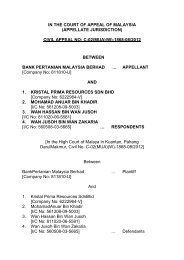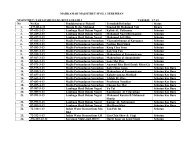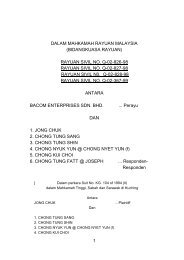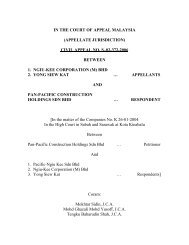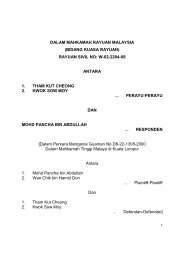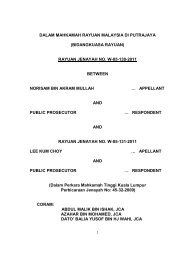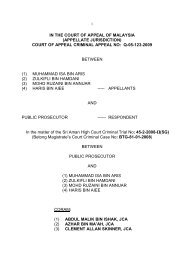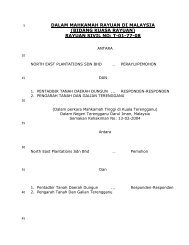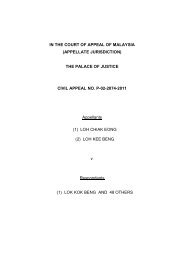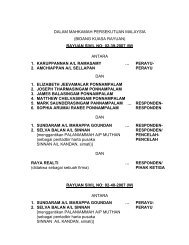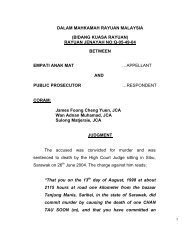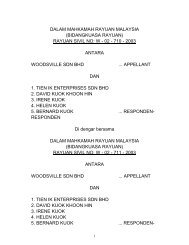DALAM MAHKAMAH RAYUAN MALAYSIA RAYUAN JENAYAH NO ...
DALAM MAHKAMAH RAYUAN MALAYSIA RAYUAN JENAYAH NO ...
DALAM MAHKAMAH RAYUAN MALAYSIA RAYUAN JENAYAH NO ...
You also want an ePaper? Increase the reach of your titles
YUMPU automatically turns print PDFs into web optimized ePapers that Google loves.
1<br />
<strong>DALAM</strong> <strong>MAHKAMAH</strong> <strong>RAYUAN</strong> <strong>MALAYSIA</strong><br />
<strong>RAYUAN</strong> <strong>JENAYAH</strong> <strong>NO</strong>: B-05-105-2008<br />
ANTARA<br />
T. PARAMASPARAN A/L THANIGAJALAM ------ PERAYU<br />
DAN<br />
PENDAKWA RAYA ------ RESPONDEN<br />
Dalam Mahkamah Tinggi Malaya Di Shah Alam<br />
Perbicaraan Jenayah No: 45-2-2003<br />
Di Antara<br />
Pendakwa Raya<br />
Dan<br />
T. Paramasparan a/l Thanigajalam<br />
CORAM:<br />
(1) HASAN LAH, JCA<br />
(2) ABDUL MALIK BIN ISHAK, JCA<br />
(3) MOHTARUDIN BIN BAKI, HCJ
Introduction<br />
2<br />
ABDUL MALIK BIN ISHAK, JCA<br />
DELIVERING THE JUDGMENT OF THE COURT<br />
[1] Before the High Court at Shah Alam, the appellant was charged<br />
for murdering his wife by the name of Mageswary a/p Sonny @ Veeran on<br />
28.10.2002 between 8.30 p.m. to 9.30 p.m. at house number 9, Solok<br />
Dato’ Abd. Hamid 16A, Taman Sri Sentosa, in the district of Klang in the<br />
State of Selangor Darul Ehsan, an offence punishable under section 302 of<br />
the Penal Code.<br />
[2] The appellant was convicted and sentenced to death by the High<br />
Court at Shah Alam and he now appeals to this Court.<br />
The prosecution’s case<br />
[3] Lim Kok Woon (SP2) and his wife Tan Kim Liew (SP7) stayed<br />
next door to the appellant’s house. As a neighbour, SP2 knew that the<br />
appellant stayed with his wife and daughter but SP2 did not mix with them.<br />
On 27.10.2002 at about 10.00 a.m. while SP2 was in his house, he heard<br />
loud voices of someone quarrelling that came from the appellant’s house.<br />
SP2 testified that he only heard a loud male voice emanating from the<br />
appellant’s house. SP2 then left his house to go to work.
3<br />
[4] When SP2 was being cross-examined by the defence, it was put<br />
to SP2 that the loud voices could possibly come from the radio of his<br />
neighbour’s house. But SP2 was adamant and insisted that that was the<br />
voice of someone quarrelling and it came from the appellant’s house.<br />
[5] SP7 is the wife of SP2. She testified that on a date which she<br />
could not remember, at about 9.00 a.m., she heard a loud noise of a male<br />
voice coming from the appellant’s house.<br />
[6] The testimonies of SP2 and SP7 showed that there was a quarrel<br />
that took place in the appellant’s house and it can be surmised that the<br />
quarrel was between the appellant and his wife in the appellant’s house on<br />
the day in question.<br />
[7] Next, we have the evidence of the appellant’s father by the name<br />
of Thanigajalam a/l Ekamparam (SP8) who testified that on 28.10.2002 he<br />
received a telephone call from the appellant who complained that the<br />
deceased (the late wife of the appellant) had assaulted the appellant with a<br />
broom and was behaving like a mad person. SP8 advised the appellant to<br />
refrain from quarrelling and that SP8 would meet the appellant after work.<br />
[8] SP8 then went to the appellant’s house. Upon arrival he found<br />
that the appellant’s house was locked and he knocked at the door but no<br />
one opened it. SP8 then returned home.
4<br />
[9] SP8 felt uneasy and he went to the appellant’s house for the<br />
second time. This time SP8 was accompanied by his wife, Nancy Rose a/p<br />
Patinathan (SP5) and another child of his. On arrival at the appellant’s<br />
house, SP8 found the front door was slightly ajar.<br />
[10] SP5 also confirmed that she went on the day of the incident at<br />
about 11.45 p.m. to the appellant’s house together with her husband, her<br />
mother-in-law as well as her father-in-law (SP8). According to SP5, she did<br />
not enter the appellant’s house but she could see that the deceased was<br />
lying motionless on the sofa and SP5 then telephoned the police.<br />
[11] The police arrived between 12.30 a.m. to 1.00 a.m. on<br />
29.10.2002. It was only after the arrival of the police that SP8 and SP5<br />
entered the appellant’s house and saw the deceased lying on the sofa with<br />
injuries to her face.<br />
[12] Now, the evidence of SP8 showed that on 28.10.2002 there was<br />
a quarrel between the appellant and the deceased. This piece of evidence<br />
emanating from SP8 was not questioned by the defence at all.<br />
[13] Corporal Samad bin Haji Ketu (SP4) was on duty at the<br />
operations room of IPD Klang on 29.10.2002 when he received a telephone<br />
call from SP5 stating that there was a quarrel between husband and wife at<br />
the address as per the charge. SP4 quickly despatched a patrol car to the<br />
scene of the crime and he was duly informed that one female Indian had
5<br />
since passed away. SP4 lodged a police report to that effect vide Klang<br />
report number 34926/2002. And this police report was marked as exhibit<br />
(P4). The deceased was confirmed dead by Azizi bin Zahariman (SP1)<br />
from the emergency unit of Hospital Tengku Ampuan Rahimah Klang on<br />
29.10.2002 at 1.00 a.m. when SP1 arrived at the appellant’s house.<br />
[14] The investigating officer of the case is ASP Sapi’i bin Ahmad<br />
(SP6). On 29.10.2002 at 3.00 a.m., SP6 requested DSP Amidon bin Aman<br />
(SP13), a forensic specialist, to proceed to the appellant’s house and<br />
conduct forensic examination thereto. Before SP13 entered the appellant’s<br />
house, he was briefed by SP6 in regard to the facts of the case. It was in<br />
evidence that SP13 entered the appellant’s house alone in order to make<br />
an appropriate analysis. From an initial assessment, SP13 found that the<br />
back door to the appellant’s house near to the kitchen was still locked while<br />
the front door was opened wide. There was no evidence of forced entry. All<br />
the windows in the appellant’s house remained intact. There were three<br />
rooms in the appellant’s house and according to SP13 there was no sign of<br />
struggle in all the three rooms.<br />
[15] SP13 and his team then drew a sketch plan of the scene of the<br />
crime and at the same time made efforts to pin-point tell tale signs and lift<br />
relevant exhibits. SP13 seized several exhibits and handed it to SP6 and<br />
that included:
(a) a broom (P23A);<br />
(b) a yellowish brown coloured woman’s clothing (P19C);<br />
(c) a plastic bottle containing strands of hair (P22A); and<br />
(d) a bottle containing blood (P21).<br />
6<br />
[16] According to SP13, he found traces and trickles of blood at the<br />
living room of the appellant’s house. From initial investigations and<br />
analysis, SP13 concluded that there was no forced entry into the<br />
appellant’s house. And that traces and trickles of blood together with the<br />
clumps of hair were only found and confined to the living room area and<br />
this showed that the struggle and the quarrel centred at the living room<br />
area of the appellant’s house.<br />
[17] On the direction of SP6, the deceased body was brought to the<br />
Hospital Tengku Ampuan Rahimah, Klang for post mortem to be conducted<br />
by Dr Nurliza binti Abdullah (SP19). The post mortem was conducted by<br />
SP19 and SP16 identified the dead body as Mageswary a/p Sonny @<br />
Veeran. Subrayam a/l Perumal, the uncle of the deceased, also identified<br />
the deceased’s body.<br />
[18] The post mortem report marked as exhibit (P5) was prepared by<br />
SP19 and it was a complete and extensive report. Exhibit (P5) reads as<br />
follows:
“The following were the external marks of trauma on the body:<br />
Head and Neck:<br />
7<br />
1) Over the mid-forehead, there was a bruised swelling of 3.5 x 3 cm.<br />
2) Over the right lower eyelid, there was a bruised swelling of 4.5 x<br />
2.5 cm.<br />
3) Over the lateral aspect of right eye, there was another faint<br />
bruised swelling of 4 x 3 cm.<br />
4) Over the right angle of mandible, there was a small bruise of 1 x 1<br />
cm.<br />
5) Over the right lower side of face, there were two abrasions, each<br />
measuring 0.3 x 0.3 cm and 0.5 x 0.3 cm respectively.<br />
6) Over the chin area, there was an abrasion of 1 x 1.5 cm.<br />
7) There was a left periorbital bruised swelling of 4 x 8.5 cm.<br />
8) Over the lateral aspect of left eye, there was an abrasion of 1.5 x<br />
1.5 cm.<br />
9) Over the left lower side of face, there were several small<br />
abrasions in an area of 3 x 0.5 cm.<br />
10) Just under the chin, there was a small abrasion of 0.3 x 0.3 cm.<br />
11) Over the left lower lip, there was a bruise of 0.5 x 0.5 cm.<br />
12) Over the left lateral angle of mouth, there was a small bruise of<br />
0.5 x 0.5 cm, with yellow discolouration of the inner lining of right<br />
lateral angle of mouth.<br />
13) Over the inner lining of left upper lip, there was a lacerated bruise<br />
of 2.5 x 2.0 cm.<br />
Trunk of Body:<br />
14) Over the right upper medial quadrant of breast adjacent to the<br />
nipple, there were three abrasions measuring 0.7 x 0.3 cm, 0.5 x<br />
0.2 cm and 0.5 x 0.2 cm respectively.<br />
15) Over the right lower abdominal wall, there was a linear bruise of<br />
14 cm long.<br />
16) Below and almost parallel to wound (12), on the right lower<br />
abdomen, there was a patterned bruise (‘shapped like a hook’)<br />
measuring 21 cm in total length.<br />
17) Over the anterior aspect of right shoulder, there was a healed<br />
scar of 6 x 1 cm, superimposed on a hyperpigmented ‘birth mark’<br />
lesion.<br />
18) Across the lower abdominal wall, there was a caesarean (surgical)<br />
scar lesion of 16.5 cm long.<br />
19) Over the right upper flank area, there was a patterned, reddish<br />
mark measuring 14 x 5 cm.<br />
20) Over the right mid-flank near the subcostral region, there were<br />
punctate abrasions in an area of 4.5 x 2 cm.<br />
21) Over the right lower flank area, there was a curved bruise of 6 cm<br />
long.
8<br />
22) Below to wound (18) on the right lower flank, there was bruise of<br />
6.5 x 4 cm.<br />
23) Over the left scapular area of back, there was a ‘tramline-shaped’<br />
bruise of 4 x 0.5 cm.<br />
24) Over the left upper back, there was another ‘tramline-shaped’<br />
bruise of 9 x 1 cm.<br />
25) Below wound (21) over the left upper back, there was an abrasion<br />
of 1.5 x 2 cm.<br />
26) Over the left mid-back near to the midline, there was a ‘tramlineshaped’<br />
bruised abrasion of 16.5 x 0.5 cm.<br />
27) Below wound (23), near the left lower back, there was a ‘tramlineshaped’<br />
bruise abrasion of 7.5 x 1.8 cm.<br />
28) Over the left giuteal region, there were punctate abrasions in an<br />
area of 4.5 x 1 cm with surrounding bruising. Adjacent to this<br />
wound, there were a 3 cm linear abrasion and a group of linear<br />
abrasions in an area of 4.5 x 1.5 cm.<br />
29) Below wound (25) over the inner lower quadrant of left giuteal<br />
region, there was a linear abrasion of 7 cm long.<br />
30) Below wound (26) over the left giuteal region, there (was) an<br />
abrasion of 1 cm long and another abrasion of 2.3 cm long.<br />
31) Near the right mid-back area, there was a faint area of confluent<br />
bruisings measuring 23 x 16 cm.<br />
32) Below wound (28) on the right mid-back, there was a ‘tramlineshaped’<br />
bruising of 9 x 0.5 cm.<br />
33) Over the right lower back, there was a faint ‘tramline-shaped’<br />
bruise of 10 x 1 cm with an adjacent bruise measuring 11 x 9 cm.<br />
Upper Limbs:<br />
34) Over the left deltoid region of arm, there was a bruise of 15 x 8<br />
cm.<br />
35) Over the left lower arm, there was a bruise of 16 x 7 cm.<br />
36) Over the left elbow region, there was an abrasion of 0.5 x 0.2 cm.<br />
37) Over the left lower posterior arm, there was another small<br />
abrasion of 1.5 x 2.5 cm.<br />
38) Over the left mid-posterior forearm, there was a linear abrasion of<br />
4 cm long, associated with surrounding bruisings of 15 x 20 cm.<br />
39) Over the left dorsum of hand, there was a bruised swelling of 15 x<br />
14 cm.<br />
40) Over the right lower arm, there was a healing linear abrasion of 2<br />
cm long.<br />
41) Over the lateral aspect of right elbow joint, there was an abrasion<br />
of 1 x 0.7 cm and over the right elbow prominence, there was<br />
another small abrasion of 0.5 x 0.3 cm, with surrounding bruising<br />
of 16 x 7.5 cm.<br />
42) Over the right upper forearm medially, there was a healed<br />
superficial incised wound of 4.5 x 0.3 cm.<br />
43) Over the right lower forearm, there were bruisings in an area of 23<br />
x 12 cm.
9<br />
44) Over the ulnar aspect of right wrist, there was a superficial<br />
incised wound (clean-cut edges) measuring 2 cm long with a<br />
healed incised wound of 2.2 x 0.3 cm.<br />
45) Over the third right knuckle of hand, there was a small abrasion of<br />
1.5 x 0.5 cm.<br />
46) Over the right dorsum of hand, there was a bruised swelling of 17<br />
x 15 cm.<br />
Lower Limbs:<br />
47) Over the lateral aspect of right upper thigh, there was a ‘tramlineshaped’<br />
bruise of 10 x 1 cm.<br />
48) Over the medial aspect of right upper leg, there were abrasions in<br />
an area of 5.5 x 2 cm with extensive bruising of the medial aspect<br />
of right leg.<br />
49) Over the medial malleolus of right ankle, there was a bruise of 4.5<br />
x 4 cm.<br />
50) Over the right dorsum of foot, there was a ‘tramline-shaped’<br />
bruise of 5.5 x 0.5 cm.<br />
51) Over the right plantar aspect of foot, there were linear abrasions<br />
in an area of 2.5 x 2 cm (lateral aspect) and another abrasion of<br />
0.2 x 0.2 cm (medial aspect).<br />
52) Over the medial aspect of right lower thigh, there was a bruise of<br />
12.5 x 7.5 cm.<br />
53) Over the right lower leg, there were a curved abrasion of 2.5 cm<br />
long, a linear abrasion of 4 cm long and a small abrasion of 1 cm<br />
long with surrounding bruisings.<br />
54) Over the right dorsum of foot, there was a bruise of 12 x 11 cm.<br />
55) Over the left knee, there was a bruise of 8 x 13 cm.<br />
56) Over the left upper shin, there was an abrasion of 1.5 x 0.5 cm.<br />
57) Over the left upper thigh medially, there was a bruise of 3.5 x 2.0<br />
cm.<br />
58) Over the left mid-thigh medially, there was a linear abrasion of 16<br />
cm long.<br />
59) Over the left lower thigh medially, there was a linear abrasion of<br />
4.1 cm long with surrounding bruisings of 1.5 x 6 cm.<br />
60) Over the medial aspect of left upper leg, there were two linear<br />
abrasions of 2.0 cm long and 2.5 x 0.5 cm respectively.<br />
61) Over the left mid-shin, there was a superficial linear laceration of<br />
3 cm long with surrounding bruisings.<br />
62) Over the left lower leg medially, there was an abrasion of 1.0 cm<br />
long.<br />
63) There was an extensive bruising over the posterolateral aspect of<br />
the left giuteal and thigh measuring in an area of 48 x 33 cm.<br />
64) Over the 1st metatarsal area of left foot, there was a bruise of 3.5<br />
x 3.0 cm.<br />
The external genitalia was that of an adult female with non-intact<br />
hymen. There were no evidence of recent trauma of the external
say:<br />
10<br />
genitalia. Rigor mortis was partially present and hypostatic lividity<br />
was unable to visualise over the back.”<br />
[19] In regard to the internal examination, exhibit (P5) had this to<br />
“INTERNAL EXAMINATION<br />
Head and Neck:<br />
Upon reflecting the scalp, there was global scalp haematoma<br />
noted with patchy contusions of the temporaiis muscles. The<br />
skull and dura matter were intact. The brain was soft and showed<br />
minimal patchy subarachnoid haemorrhage of the left cerebral<br />
interhemispheric area and right occipital pole of cerebrum. One<br />
serial sectioning of the cerebrum, there were scattered petechiai<br />
haemorrhages of its white matter, but there were no intracerebral<br />
haemorrhages or focal lesions seen. The basal vessels were patent<br />
and thin-walled. Apart from the minimal congestion of cerebellum,<br />
there were no other gross pathology of the cerebellum and<br />
brainstem externally and on cut sectioning.<br />
The tonge showed deep muscle bruising of its right lateral aspect.<br />
The epiglottis, tonsiis and pharyngeai muscles were normal. The<br />
hyoid bone and thyroid cartilage were intact. Both the carotid<br />
arteries were patent and free of atheroma. The cervical spine was<br />
intact.<br />
Thorax:<br />
The rib cage was intact. The pleural cavities were clear and dry. The<br />
upper airways were unobstructed. The left and right lung were<br />
moderately congested and showed areas of capsular contusions.<br />
The right lung was also mildly oedematous. The pericardium were<br />
intact. The heart was of normal size and shape. The cardiac valves<br />
and chambers were within normal limits. The right coronary artery<br />
was small-sized but patent. The left anterior descending and<br />
circumflex arteries were patent and free of atheromatous plaques.<br />
On sectioning, the myocardium was firm and healthy.<br />
There was no evidence of pulmonary thromboembolism. The<br />
oesophegus was empty.<br />
Abdomen:<br />
The peritoneai cavity was clear and dry. The stomach contained<br />
minimal fluid. Its gastric mucosa was unremarkable. The small and
11<br />
large intestines were externally normal. The liver showed capsular<br />
contusions over its anterior aspect of left lobe with localised<br />
subcapsular haematoma of its right lobe. On serial sectioning of the<br />
liver its cut surfaces showed patchy areas of pallor. The spleen was<br />
structurally intact but on cut sectioning showed patchy areas of<br />
intraparenchymal bleed. The common bite duct was patent. The<br />
gallbladder, pancreas and adrenal glands were unremarkable. The<br />
left kidney showed smooth capsular surface but upon bisecting,<br />
there were frank pus within pelvicallyceal system. The right kidney<br />
showed smooth capsular surface with normal pelvicallyceal system.<br />
The urinary bladder was intact.<br />
The gravid uterus corresponded to a 32-33 weeks gestational size<br />
with an intact, grossly normal baby boy (stillborn) in – utero, in<br />
cephalic presentation and with adequate liquor. The lower segment<br />
of uterus showed minimal adhesions over the surgical scar area. The<br />
placenta was fundally placed in utero and attached en masse with<br />
the umbilical cord. Both the ovaries and fallopian tubes were present<br />
and intact. The abdominal aorta was free of atheromatous plaques.<br />
Skeleton: Intact.”<br />
[20] The summary and the cause of death of the deceased listed in<br />
exhibit (P5) are as follows:<br />
“SUMMARY/CONCLUSION:<br />
I was informed by the police that this 25 year old Indian lady was<br />
found apparently dead lying within a house in Taman Sentosa, Klang<br />
area in the early morning of 29/10/2002, following a report of<br />
domestic quarrel.<br />
Post mortem examination revealed diffuse and extensive soft tissue<br />
injuries of blunt force type comprising of bruisings and abrasions<br />
over the head, trunk of body and limbs associated with evidence of<br />
traumatic shock. The internal findings at post mortem also revealed<br />
associated subarachnoid haemorrhages of cerebrum, lung and liver<br />
contusions with parenchymal bleeds in the spleen.<br />
There were no significant underlying disease processes which had<br />
contributed to the death. The deceased was also 8 months pregnant<br />
with a grossly normal preterm baby which was stillborn.<br />
In my opinion, the cause of death is attributable to traumatic shock<br />
as a consequence of the diffuse blunt force injuries to the body<br />
sustained by the deceased.
CAUSE OF DEATH:<br />
12<br />
(a) TRAUMATIC SHOCK (due to)<br />
(b) DIFFUSE BLUNT FORCE INJURIES TO THE BODY.”<br />
[21] It must be borne in mind that at the time of her death, the<br />
deceased was pregnant with a “grossly normal baby boy (still born)”.<br />
[22] According to the good doctor, the injuries sustained by the<br />
deceased were not accidental. The injuries to the back of the deceased<br />
could not have been self inflicted. The good doctor also dismissed the<br />
suggestions by the defence that the injuries sustained by the deceased<br />
were self inflicted or due to epilepsy. Finally, the good doctor testified that<br />
the cause of death was due to injuries sustained from punches and blows<br />
using a blunt instrument.<br />
[23] Anna a/p Krishnan (SP3), the mother of the appellant also gave<br />
evidence for the prosecution. SP3 testified that on 28.10.2002 at about<br />
10.00 p.m., her other son by the name of Sivakumar a/l Thanigajalam<br />
brought the appellant to her house. SP3 spoke to the appellant that night<br />
and according to SP3, her son – the appellant, appeared to be extremely<br />
frightened and he was crying. SP3 asked the appellant as to what had<br />
happened and the appellant stated that there was an argument between<br />
him and the deceased. The appellant told SP3 that the appellant had<br />
assaulted the deceased and left his house. SP3 allowed the appellant to<br />
spend the night at SP3’s house. The evidence of SP3 was not challenged
13<br />
at all. Thus, the evidence of SP3 tallied with the prosecution’s version that<br />
the appellant left his house after quarrelling and assaulting the deceased<br />
on 28.10.2002.<br />
namely:<br />
[24] The learned High Court Judge made specific finding of facts,<br />
(a) that there was a quarrel between the appellant and the deceased<br />
at the appellant’s house on 28.10.2002;<br />
(b) that the appellant assaulted the deceased repeatedly during the<br />
quarrel; and<br />
(c) that the deceased suffered traumatic shock as a result of the acts<br />
of the appellant that led to her death.<br />
[25] The learned High Court Judge called the defence of the<br />
appellant for an offence under section 302 of the Penal Code and the<br />
appellant gave evidence on oath.<br />
The appellant’s defence<br />
[26] In his defence, the appellant referred to his cautioned statement<br />
that was made on 29.10.2002 at 5.00 p.m., and tendered it as exhibit<br />
(D31). The appellant read in open court his cautioned statement and he<br />
admitted its contents as the truth. The following are excerpts of the<br />
appellant’s cautioned statement:
14<br />
(a) That he noticed his wife’s behaviour in the last two or three days<br />
had changed especially in association and conversation and so<br />
on 27th October 2002 at about 8.30 p.m. he took his wife out to<br />
dinner at Bukit Kuda so that they could talk about her change in<br />
attitude.<br />
(b) His wife said that she had not changed and that there was<br />
nothing wrong that he had done to her and that she still loved<br />
him.<br />
(c) They both returned home after dinner and watched a Tamil<br />
movie on television. She was lying down on a mattress on the<br />
floor and he was lying on the sofa.<br />
(d) When he was about to change the CD he noticed that she was<br />
hugging a pillow in a state of arousal. So he switched off the<br />
television and lifted her and put her against the sofa and asked<br />
her questions, in this manner, “I thought that you were asleep.<br />
At dinner just now you said there was no difference of<br />
opinion but now that you can ‘menguit-guit tilam dan khayal’<br />
clearly shows that there is change”.<br />
(e) She still maintained that there was nothing wrong. He then<br />
kissed her and went on to have sexual intercourse with her and<br />
after that he went to have a bath.
15<br />
(f) He came out of the bathroom and noticed that his wife was still<br />
behaving in the same manner “berkelakuan yang sama<br />
muram, memikirkan sesuatu”. He gave her a towel and asked<br />
her to take a bath.<br />
(g) When she came out of the bathroom after her bath, he again<br />
asked about her “kemuraman” and she still maintained her<br />
silence.<br />
(h) He was not satisfied when she did not give an answer and this<br />
prompted him to take her to the prayer room and asked her to<br />
promise in front of the picture of the god she prays to. She was<br />
still stubborn and remained silent.<br />
(i) He became angry and slapped her. She cried and she said for<br />
the first time that she had concealed something from him and<br />
that she was unfaithful (“telah berlaku curang”).<br />
(j) He then brought her to the living room and asked her what<br />
actually had happened. This time she continued to be stubborn<br />
even though he had asked for forgiveness for his rough<br />
behaviour.<br />
(k) Because of her stubborness, he became angry and beat her with<br />
the rice cooker wire. She acted in a rude way towards him. She<br />
told him that the incident recently about some jewellery that went
16<br />
missing in the house was not because of theft but because she<br />
herself had given it away. He asked her to whom she had given it<br />
to and she did not reply. He could not stand it and beat her again<br />
with the rice cooker wire on her leg and her back. Only then she<br />
was willing to tell him about what had happened. He coaxed her<br />
and asked her again about what she had done. At that moment<br />
she told him that all the jewelleries which were reported lost were<br />
actually given by her to his brother, Mahadevan, who had come<br />
back from Johor Bahru.<br />
(l) Then he asked her why she had given all the jewelleries to<br />
Mahadevan and even so why she did not tell him about it. He<br />
shouted at her and asked, “Why the need to conceal that fact<br />
from him?” He also asked her about her relationship with his<br />
brother. She was evasive. He threatened her that he will make a<br />
police report to prosecute her and his brother.<br />
(m) Then his wife fell on her knees and asked for forgiveness for her<br />
mistake. He then forgave her and asked her to wash her face.<br />
She then walked from the room to the bathroom without<br />
stopping. He then forced her to wash her face and she complied.<br />
She returned to the living room.
17<br />
(n) He then asked her about her relationship with his brother which<br />
she was willing to conceal from him until now. At this point of<br />
time, she admitted that she was unfaithful and that she has an<br />
affair with his younger brother by the name of Mahadevan.<br />
(o) When he heard this, he immediately told her that he no longer<br />
wanted to live with her. He telephoned his brother-in-law, Murthi,<br />
who lives in Taman Sentosa, the sister-in-law of his wife, Sasi,<br />
who lives in Puchong and asked his wife to tell them about her<br />
behaviour.<br />
[27] In his testimony, the appellant confirmed that he had made a<br />
cautioned statement to the police. He testified that at about 1.00 a.m., he<br />
took his wife to their prayer room and there he told his wife to swear in front<br />
of the altar of the goddess but she remained silent. And the picture of the<br />
goddess fell to the ground. When his wife admitted her infidelity, he was<br />
shocked and he stopped beating his wife and he sat down. He admitted<br />
using a rice cooker wire to beat up his wife – the deceased. And after he<br />
came to know of his wife’s infidelity, he used a broom stick to beat her up.<br />
He testified that he panicked and could not control himself when he beat<br />
his wife with a broom stick. He could not remember how many times he hit<br />
his wife because at that time he was in a fit of anger. He testified that the<br />
last time that he beat his wife was at about 6.00 a.m. He testified that at
18<br />
about 10.00 a.m. to 10.30 a.m. he telephoned his brother-in-law by the<br />
name of Murthi. His call was answered by Murthi’s wife. His wife spoke and<br />
told Murthi’s wife that there had been a big mistake in that she has had an<br />
affair with her brother-in-law. His wife at that time appeared normal and she<br />
was crying. He testified that he could not sleep and that when he came<br />
back from the shop on 28.10.2002, he saw his wife lying on the sofa. He<br />
telephoned his father. He did not know at that time that his wife had died.<br />
He never intended to kill her. He did not know that his beatings could have<br />
killed her. He never tried to strangle her during the quarrel nor did he use<br />
the rice cooker wire to strangle her.<br />
[28] Under cross-examination, he identified the photographs of his<br />
wife – the deceased. He also identified the photograph of his house. He<br />
admitted that he telephoned his father (SP8) on 28.10.2002 and told him<br />
about the fight. His father advised him not to fight. Soon thereafter, he left<br />
his house and met Sivakumar a/l Thanigajalam who brought him to Taman<br />
Eng Aun. From there he went to see his mother (SP3). He said that he<br />
never telephoned the hospital to know about the condition of his wife. He<br />
admitted that his wife was in her advanced stage of pregnancy. He had no<br />
intention to kill his wife. He agreed that he had slapped, hit and kicked her.<br />
He admitted that he used a rice cooker wire to beat his wife. He said that if<br />
his wife had told him about the infidelity matter earlier they could have
19<br />
discussed it and it would not turn out to be like this. He said that<br />
Mageswary was his wife. Ours, according to him, was a love marriage and<br />
that he still loved her. Her actions made him think that she had cheated him<br />
and made him look stupid. He denied that the allegation about her adultery<br />
with his brother was fictitious. According to the appellant, he assaulted his<br />
wife because he was angry that she did not answer his questions.<br />
[29] Under re-examination, he said that he knew for the first time<br />
about his wife having an affair with his brother Mahadevan was when he<br />
was quarrelling with his wife.<br />
The Petition of Appeal<br />
(i) Prima facie case<br />
[30] After hearing the evidence of the prosecution, the learned High<br />
Court Judge was satisfied that the defence of the appellant should be<br />
called. His Lordship did not say it in clear terms, but in assessing the<br />
evidence at the prosecution’s stage on a maximum evaluation basis he has<br />
determined that a prima facie case was established (section 180(1) of the<br />
Criminal Procedure Code; Balachandran v. PP [2005] 1 CLJ 85, FC; and<br />
Looi Kow Chai & Anor v Pendakwa Raya [2003] 2 AMR 89, CA). At<br />
pages 172 to 173 of the appeal record at Jilid II, this was what the learned<br />
High Court Judge said in his written judgment:<br />
“Untuk membuktikan pertuduhan di bawah s. 302 Kanun Keseksaan,<br />
Pendakwaan juga perlu membuktikan OYDT telah dengan niat dan
follows:<br />
20<br />
dengan sengaja mendatangkan kecederaan kepada Si mati. Si mati<br />
mengalami kecederaan di keseluruhan badan dan laporan post<br />
mortem menunjukkan ia dipukul berkali-kali. Si mati juga dalam<br />
keadaan sarat mengandung. Oleh itu perlakuan OYDT mendatangkan<br />
kecederaan yang bertubi-tubi ke atas keseluruhan tubuh badan Si<br />
mati menunjukkan perbuatan itu dilakukan dengan sengaja dan<br />
mempunyai niat untuk membunuh. SP19 dalam keterangannya di<br />
Mahkamah telah menyatakan kecederaan-kecederaan yang dialami<br />
oleh Si mati yang boleh disebabkan oleh tumbukan; terdapat<br />
kecederaan yang disebabkan oleh objek yang tumpul; terdapat<br />
kecederaan yang disebabkan oleh objek yang tirus dan panjang yang<br />
kemungkinannya disebabkan oleh P24B (wayar beserta cable dan<br />
soket); terdapat kecederaan yang disebabkan oleh objek cylindrical<br />
dan panjang; terdapat kecederaan yang boleh disebabkan oleh<br />
batang penyapu (P23A) dan terdapat juga kecederaan yang mungkin<br />
disebabkan oleh tendangan. Terdapat terlalu banyak kecederaan di<br />
atas badan Si mati dan pukulan-pukulan itu telah dihasilkan oleh<br />
objek yang berbeza termasuk tangan, tendangan, kemungkinan<br />
digunakan penyapu dan juga wayar. Saya berpuashati daripada<br />
kesemua keterangan yang dikemukakan oleh pendakwaan secara<br />
keseluruhannya mencukupi untuk membuktikan elemen-elemen<br />
pertuduhan ini. Oleh itu Mahkamah ini telah memanggil OYDT<br />
membela diri atas pertuduhan di bawah s. 302 KK.”<br />
[31] Murder is defined in section 300 of the Penal Code. It states as<br />
“300. Murder.<br />
Except in the cases hereinafter excepted, culpable homicide is<br />
murder –<br />
(a) if the act by which the death is caused is done with the<br />
intention of causing death;<br />
(b) if it is done with the intention of causing such bodily injury<br />
as the offender knows to be likely to cause the death of the<br />
person to whom the harm is caused;<br />
(c) if it is done with the intention of causing bodily injury to any<br />
person, and the bodily injury intended to be inflicted is<br />
sufficient in the ordinary course of nature to cause death; or<br />
(d) if the person committing the act knows that it is so<br />
imminently dangerous that it must in all probability cause<br />
death, or such bodily injury as is likely to cause death, and<br />
commits such act without any excuse for incurring the risk of<br />
causing death, or such injury as aforesaid.”
(a) Intention to kill<br />
21<br />
[32] An intention to kill is the most important mental element in<br />
murder. Intention can be inferred by looking at the conduct of the offender.<br />
Thus, if a lethal weapon is used by the offender in the killing, an intention to<br />
kill may be inferred. And where the offender attacked a vital part of the<br />
victim’s body, an intention to kill is inferred.<br />
(b) Intention to cause such bodily injury as the offender knows is<br />
likely to cause death<br />
[33] In the context of the present appeal, this clause (b) do not apply.<br />
It concerns the situation where the offender had some special knowledge of<br />
the condition of the victim which would lead to his death where an injury is<br />
inflicted thereto. For example, if the offender knows that the victim was a<br />
haemophiliac and causing grievous hurt to him would result in his death,<br />
that would be murder.<br />
(c) Intention to cause bodily injury which is sufficient in the ordinary<br />
course of nature to cause death<br />
[34] This is the most frequently used murder provision in our courts.<br />
In Virsa Singh v. State of Punjab AIR 1958 SC 465, the Indian Supreme<br />
Court interpreted section 300(c) of the Indian Penal Code (just like our own<br />
section 300(c) of the Penal Code) in erudite terms. Briefly, in that case, the<br />
victim was injured by a spear thrust by the accused and died 21 hours later
22<br />
from peritonitis caused by the wound. It was argued that the prosecution<br />
had to prove that the intention in the first clause of section 300(c) of the<br />
Indian Penal Code must relate to the second clause in that “the bodily<br />
injury intended to be inflicted is sufficient in the ordinary course of<br />
nature to cause death”. Flowing from this, it was argued that the<br />
prosecution had to establish that the accused intended to cause the injury<br />
and knew that the injury was sufficient in the ordinary course of nature to<br />
cause death. The Indian Supreme Court rejected this argument and laid<br />
down the law in this manner:<br />
“First, it must establish, quite objectively, that a bodily injury is<br />
present. Secondly, the nature of the injury must be proved. These are<br />
purely objective investigations. Thirdly, it must be proved that there<br />
was an intention to inflict that particular bodily injury, that is to say,<br />
that it was not accidental or unintentional or that some other kind of<br />
injury was intended. Once these elements are proved to be present,<br />
the enquiry proceeds further. Fourthly, it must be proved that the<br />
injury of the type just described made up of the three elements set<br />
out above is sufficient to cause death in the ordinary course of<br />
nature. This part of the enquiry is purely objective and inferential and<br />
has nothing to do with the intention of the offender.”<br />
[35] In construing section 300(c) of the Penal Code, the courts<br />
should apply a subjective test in order to determine whether the injury was<br />
intentionally inflicted. And whether the injury was of the type that would be<br />
ordinarily fatal is usually dependent on the medical evidence (Basappa<br />
Bhimappa Doddamani v. State [1961] AIR Mysore 21; and In re, Dadi<br />
Abdul Gaffoor [1955] AIR Andhra 24).
23<br />
(d) Knowledge that the act was so imminently dangerous that it must<br />
in all probability cause death<br />
[36] Section 300(d) of the Penal Code is based on knowledge<br />
whereas the other three clauses are concerned with intention. It is ideal to<br />
refer to the case of State of Madhya Pradesh v. Ram Prasad [1968] 2<br />
SCR 522, a decision of the Indian Supreme Court. In that case, the<br />
accused had set fire to his wife’s clothing after pouring oil on her.<br />
Hidayatullah J had this to say (see page 527):<br />
“Although clause fourthly is usually invoked in those cases where<br />
there is no intention to cause death of any particular person (as the<br />
illustration shows) the clause may on its terms be used in those<br />
cases where there is such callousness towards the result and the<br />
risk taken is such that it may be stated that the person knows that<br />
the act is likely to cause death or such bodily injury as is likely to<br />
cause death.”<br />
[37] His Lordship Hidayatullah J continued in serious vein at the<br />
same page:<br />
“No special knowledge is needed to know that one may cause death<br />
by burning if he sets fire to the clothes of a person.”<br />
(ii) The defence of sudden fight<br />
[38] This defence was not raised before the learned High Court<br />
Judge but raised for the first time before this Court. Abdul Hamid Mohamad<br />
FCJ (later Chief Justice of Malaysia) in PP v. Awang Raduan Awang Bol<br />
[2005] 1 CLJ 649, FC, at page 655 aptly said:
24<br />
“In the present case, like in Mohamed Kunjo (supra), the defence was<br />
never raised in the High Court or in the Court of Appeal. But the<br />
Court of Appeal took upon itself to consider the defence in its<br />
judgment. The court had in fact gone further than what had<br />
happened in Mohamed Kunjo (supra). In that case, at least the<br />
defence was raised by the appellant before the Privy Council.<br />
However, we are prepared to accede that the Court of Appeal was not<br />
prevented from considering that defence but, on condition that there<br />
must be sufficient evidence upon which a reasonable tribunal could<br />
find the defence made out.”<br />
[39] The defence of sudden fight is housed in Exception 4 to section<br />
300 of the Penal Code. It reads as follows:<br />
“Exception 4 – Culpable homicide is not murder if it is committed<br />
without premeditation in a sudden fight in the heat of passion upon a<br />
sudden quarrel, and without the offender having taken undue<br />
advantage or acted in a cruel or unusual manner.<br />
Explanation – It is immaterial in such cases which party offers the<br />
provocation or commits the first assault.”<br />
[40] Now, to come within the exception of sudden fight, the following<br />
four facts must be proved:<br />
(a) that there is a sudden fight in the heat of passion upon a sudden<br />
quarrel;<br />
(b) that there is no premeditation;<br />
(c) that the offender does not take undue advantage or act in a cruel<br />
or unusual manner; and<br />
(d) it is immaterial who started the fight first.<br />
[41] Because of the use of the word “sudden”, if there is a fight that<br />
fight is not pre-arranged. In other words, there should not be a lapse
25<br />
between the quarrel and the fight. If there is such an intervening period, it<br />
means that “reason” would by then overcome “passion” and the fight is<br />
said not to be sudden. This seems to be the view of Dr. Sir Hari Singh<br />
Gour, The Penal Law of India (Diamond Jubilee - Tenth Edition,<br />
volume III, 1983), at page 2368, where the learned editors had this to say:<br />
“Heat of passion requires that there must be no time for the passion<br />
to cool down...... .”<br />
[42] However, the Penal Code does not define the meaning of the<br />
word “fight”. “Britannica World Language Edition of the Oxford<br />
Dictionary” defines “fight” as “the action of fighting”. It takes two to<br />
start a fight. If blows are exchanged then there is a fight. But if it is only a<br />
one-sided attack with no response from the adversary, then it is not a fight.<br />
And if the adversary dies as a result of the blow, the attacker cannot take<br />
advantage of Exception 4 because at the time when the attacker gives the<br />
fatal blow, there was no fight.<br />
[43] There must be no premeditation. The killing must be in the heat<br />
of passion upon a sudden quarrel. You can prove premeditation by way of<br />
direct or circumstantial evidence. Guidelines have been laid down by the<br />
Privy Council in Mohamed Kunjo v. Public Prosecutor [1978] 1 MLJ 51<br />
in respect to the reception of Exception 4 to section 300 of the Penal<br />
Code. The facts of that case may be stated as follows. Two good friends
26<br />
were drinking together when a quarrel broke out. They fought one another.<br />
They grappled each other and fell to the ground and they continued to<br />
wrestle and exchanged punches. Both of them were drunk and because of<br />
that they both fell down and got up again several times. Suddenly the<br />
accused disengaged himself from the fight and ran towards the store where<br />
a motor lorry was parked and there the accused picked up the exhaust pipe<br />
of a motor vehicle and used it as a weapon. Armed with the exhaust pipe,<br />
the accused attacked the deceased who was at that time on a standing<br />
posture and delivered a blow to the head of the deceased. The deceased<br />
tried to ward off any further blows by using his hands but failed to do so<br />
and fell to the ground. The accused continued to hit the deceased on the<br />
head three or four times with the exhaust pipe. When the ambulance<br />
arrived, the deceased was already dead. An autopsy was done and it was<br />
revealed that the deceased had died of a fractured skull. The autopsy also<br />
showed that one of the fractures was incurred after the deceased had died.<br />
[44] Lord Scarman delivering the judgment of the Privy Council in<br />
Mohamed Kunjo v. Public Prosecutor (supra) and based on the<br />
evidence held that the blows were struck “in a sudden fight in the heat of<br />
passion upon a sudden quarrel” (see page 54). According to Lord<br />
Scarman the act that caused the death was done without premeditation.<br />
His Lordship quoted with approval the definition of “premeditation” as
27<br />
postulated by Bhandari J in Kirpal Singh v. The State [1951] AIR Punjab<br />
137, at 140 and concluded that in order to constitute a premeditated killing,<br />
there must be “an element of design or prior planning”.<br />
[45] Lord Scarman was of the opinion that the accused cannot<br />
explain that the act which caused the death was done “without the<br />
offender having taken undue advantage or acted in a cruel or unusual<br />
manner” (see page 54). Lord Scarman also defined “undue advantage”<br />
to mean an “unfair advantage” by adopting the definition as suggested by<br />
K Sahai J in Sarjug Prasad v. The State [1959] AIR Patna 66, at 69. Lord<br />
Scarman was obviously influenced by the fact that the accused had<br />
disengaged himself from the fight in order to secure a weapon – the<br />
exhaust pipe, and his Lordship described this as “truly murderous” when<br />
the accused attacked the defenceless deceased. Lord Scarman also noted<br />
that the deceased was taken by surprise and was attacked using an<br />
exhaust pipe and a heavy blow on the head could reasonably be expected<br />
to be lethal. Lord Scarman was constrained to hold that the accused had<br />
taken undue advantage or acted in a cruel or unusual manner and<br />
accordingly rejected the plea of sudden fight.<br />
[46] The crucial question to pose in the present appeal is: whether<br />
there was evidence of a sudden fight? It must be recalled that before the<br />
learned High Court Judge called for the defence of the appellant under
28<br />
section 300 of the Penal Code, his Lordship made specific finding of facts<br />
that there was a quarrel between the appellant and the deceased on<br />
28.10.2002 where the appellant assaulted the deceased repeatedly and the<br />
deceased suffered traumatic shock that led to her death. Indeed the next<br />
door neighbours SP2 and SP7 confirmed that there was a quarrel in the<br />
appellant’s house when they heard loud male voices coming from the<br />
appellant’s house. The quarrel started on 27.10.2002 at about 10.00 a.m.<br />
according to SP2 and on a date that could not be remembered at about<br />
9.00 a.m. according to SP7.<br />
[47] It makes no difference as to who started the fight first. The<br />
appellant’s father (SP8) testified that on 28.10.2002 he received a<br />
telephone call from the appellant stating that the deceased had assaulted<br />
the appellant with a broom and was behaving like a mad person. But SP2<br />
and SP7 only heard loud male voices coming from the appellant’s house<br />
akin to quarrelling. Both SP2 and SP7 did not say that they also heard loud<br />
female voices from the appellant’s house. If the deceased had actually<br />
used a broom and assaulted the appellant, the appellant would be injured<br />
and medical evidence would be introduced to show the appellant’s injury, if<br />
any. Here, there was no supportive medical report to support the<br />
appellant’s assertion.
29<br />
[48] All along, the aggressor was the appellant and not the deceased.<br />
The nature of the weapon used by the appellant was also indicative that the<br />
appellant had taken undue advantage. And when the appellant repeatedly<br />
assaulted the deceased using the rice cooker wire and a broom stick he<br />
had acted in a cruel or unusual manner. Even the cautioned statement of<br />
the appellant showed that the appellant started to assault and continue to<br />
assault the deceased even before the deceased confessed that she had an<br />
affair with the appellant’s younger brother by the name of Mahadevan. The<br />
tenacity which the appellant adopted in questioning and assaulting the<br />
deceased gave little choice for the deceased to survive the repeated<br />
onslaughts on her body. She sustained numerous injuries as set out in the<br />
post mortem report. In our judgment, the plea of sudden fight must be<br />
rejected.<br />
(iii) The defence of grave and sudden provocation<br />
[49] This defence is housed in Exception 1 to section 300 of the<br />
Penal Code. It reads as follows:<br />
“Exception 1 – Culpable homicide is not murder if the offender,<br />
whilst deprived of the power of self control by grave and sudden<br />
provocation, causes the death of the person who gave the<br />
provocation, or causes the death of any other person by mistake or<br />
accident.<br />
The above exception is subject to the following provisos:<br />
(a) that the provocation is not sought or voluntarily provoked by the<br />
offender as an excuse for killing or doing harm to any person;
30<br />
(b) that the provocation is not given by anything done in obedience<br />
to the law, or by a public servant in the lawful exercise of the<br />
powers of such public servant;<br />
(c) that the provocation is not given by anything done in the lawful<br />
exercise of the right of private defence.<br />
Explanation – Whether the provocation was grave and sudden<br />
enough to prevent the offence from amounting to murder, is a<br />
question of fact.”<br />
[50] For the appellant to succeed in raising this defence, he must<br />
show to the Court that the provocation which he received must be so grave<br />
and sudden that it has deprived him of the power of self-control. Not only<br />
that the appellant must also show that the provocation would also deprive a<br />
hypothetical reasonable man of his power of self-control. And whether the<br />
provocation is said to be so grave and sudden as to deprive a reasonable<br />
man of his power of self-control is entirely a question of fact which must be<br />
viewed and assessed objectively.<br />
[51] But Exception 1 makes no mention about the need to apply the<br />
reasonable man requirement. This means that this is not a statutory<br />
requirement but it has been developed through case law. Indeed in 1988,<br />
the Supreme Court presiding in Kota Kinabalu in the case of Lorensus<br />
Tukan v. Public Prosecutor [1988] 1 MLJ 251, speaking through Seah<br />
SCJ at page 253 aptly said:<br />
“ The test of ‘grave and sudden’ provocation is whether a reasonable<br />
man, belonging to the same class of society as the accused, placed<br />
in the situation in which the accused was placed would be so<br />
provoked as to lose his self-control (see Nanavati v. State of<br />
Maharashtra [1962] AIR SC 605, 530).”
31<br />
[52] Lord Diplock in Director of Public Prosecutions v Camplin<br />
[1978] 2 All ER 168, at 173 to 174 referred to the reasonable man as “an<br />
ordinary person of either sex, not exceptionally excitable or<br />
pugnacious, but possessed of such powers of self-control as<br />
everyone is entitled to expect that his fellow citizens will exercise in<br />
society as it is today”.<br />
[53] The provocation in the instant appeal was the confession by the<br />
appellant’s wife that she was unfaithful to the appellant in that she had an<br />
affair with the appellant’s younger brother by the name of Mahadevan. If<br />
this piece of information pertaining to his wife’s confession of infidelity was<br />
said to have provoked him to beat his wife, it cannot be sanctioned by this<br />
Court. It must be recalled that the appellant started to intimidate and<br />
assault his wife even before she confessed about her unfaithfulness. His<br />
cautioned statement showed that he questioned her right from the very<br />
beginning and applied intimidating tactics which ultimately made him angry<br />
and he then slapped her. But she remained stubborn and that made him<br />
angrier and he then beat her with the rice cooker wire. And when he came<br />
to know of his wife’s infidelity, he used a broom stick to beat her up. In his<br />
testimony he said that he panicked and could not control himself when he<br />
beat his wife with a broom stick.
32<br />
[54] The learned High Court Judge correctly assessed the evidence<br />
in regard to the defence of provocation in these erudite terms (see pages<br />
178 to 180 of the appeal record at Jilid II):<br />
“Meneliti fakta dalam kes ini saya mendapati dalam kejadian ini Si<br />
mati telah bersikap berdiam diri dan tidak memberitahu apa-apa<br />
sehingga dipukul berkali-kali oleh OYDT baharulah dia mengaku<br />
mempunyai hubungan sulit. Setelah Si mati mengaku mempunyai<br />
hubungan sulit, OYDT mengatakan dia telah terkejut dan duduk di<br />
satu tempat. Kemudian daripada itu OYDT telah memukul isterinya<br />
menggunakan penyapu dan memarahinya. Keterangan SP19 iaitu<br />
doktor yang membuat post mortem ke atas mayat Si mati<br />
menyatakan ‘kesan-kesan kecederaan berganda pada tubuh badan<br />
Si mati adalah bersesuaian dengan trauma tumpul yang dialaminya<br />
secara berkali-kali dan berterusan dalam jangka masa yang singkat’.<br />
Oleh itu dapat disimpulkan daripada keterangan OYDT dan juga<br />
SP19 ini bahawa OYDT telah memukul Si mati berkali-kali dan<br />
bertubi-tubi dengan tidak hanya menggunakan tangan tetapi wayar<br />
rice cooker dan juga penyapu. Walaupun terdapat pergaduhan dalam<br />
kes ini dan pengakuan Si mati bahawa dia telah berlaku curang tetapi<br />
tindakan OYDT ini yang memukul secara berterusan bukanlah satu<br />
tindakan secara spontan dan tindak balas kepada pengakuan Si mati<br />
itu. OYDT telah mula memukul Si mati sebelum pengakuan Si mati itu<br />
lagi. OYDT juga telah bertindak menyoal Si mati dari awal kejadian ini<br />
dan mula memukul Si mati sebelum Si mati membuat apa-apa<br />
pengakuan mengenai hubungan sulitnya. OYDT yang telah bertindak<br />
agresif dari awal kejadian pergaduhan ini dan menyoal dan memukul<br />
Si mati berkali-kali dan selepas Si mati mengaku mempunyai<br />
hubungan sulit dia telah berterusan memukul Si mati. Saya<br />
berpendapat jikapun OYDT sangat marah dengan pengakuan itu,<br />
OYDT seharusnya dapat menahan kemarahannya dan tidak memukul<br />
Si mati dengan bertubi-tubi. OYDT dapat berfikir dan mengambilkira<br />
keadaan isterinya yang sarat mengandung sebelum bertindak<br />
memukulnya secara keterlaluan. Daripada keterangan OYDT, saya<br />
mendapati Si mati telah berdiam diri dan tidak menjawab soalansoalan<br />
OYDT sehinggalah OYDT memukul, menampar dan juga<br />
memukulnya dengan wayar rice cooker. Oleh itu saya mendapati<br />
OYDT yang mendesak Si mati dan apabila Si mati mengakui<br />
mempunyai hubungan sulit dia juga telah berterusan memukul Si<br />
mati. Saya berpendapat Kecualian 1 kepada s. 300 tidak terpakai<br />
dalam kes ini. Dalam mengamati rentetan kejadian ini saya<br />
mendapati tidak ada ‘grave and sudden provocation’ dalam kes ini.”
33<br />
[55] The appellant was in complete control of the situation at all<br />
times. He remained in control throughout the episode of beating and the<br />
confession of his wife’s infidelity cannot be construed as being so grave<br />
and sudden that would deprive him of the power of self-control. Even<br />
before the confession of infidelity he had used a rice cooker wire to beat up<br />
his wife severely. She sustained sixty four (64) injuries – too much for her<br />
to bear and that led her to her death. And while inflicting all these sixty four<br />
(64) injuries on her head, neck, body trunk, upper limbs and lower limbs, he<br />
knew that she was in an advanced stage of pregnancy. No court of law<br />
properly appraised of the facts and the law could countenance his acts. It is<br />
appropriate to characterise his acts as “truly murderous” to borrow the<br />
words of Lord Scarman in Mohamed Kunjo v. Public Prosecutor (supra).<br />
No reasonable man belonging to the same class of society as the appellant<br />
and placed in the same situation in which the appellant was placed would<br />
be deprived of his power of self-control. It is our judgment that the defence<br />
of grave and sudden provocation must be rejected outright.
Conclusion<br />
34<br />
[56] For these varied reasons, we unanimously dismissed the<br />
appellant’s appeal. The conviction and sentence are hereby affirmed.<br />
14.9.2011 Dato’ Abdul Malik bin Ishak<br />
Judge, Court of Appeal,<br />
Malaysia<br />
Counsel<br />
(1) For the Appellant Accused : Mr. T. Vijayandran<br />
Solicitors : Messrs T. Vijay & Company<br />
Advocates & Solicitors<br />
Kuala Lumpur<br />
(2) For the Respondent/<br />
Public Prosecutor : Mr. Ahmad bin Bache<br />
Deputy Public Prosecutor<br />
Attorney-General’s Chambers<br />
Putrajaya
Cases referred to in this judgment:<br />
35<br />
1. Balachandran v PP [2005] 1 CLJ 85, FC.<br />
2. Looi Kow Chai & Anor v Pendakwa Raya [2003] 2 AMR 89, CA.<br />
3. Virsa Singh v. State of Punjab AIR 1958 SC 465.<br />
4. Basappa Bhimappa Doddamani v. State [1961] AIR Mysore 21.<br />
5. In re, Dadi Abdul Gaffoor [1955] AIR Andhra 24.<br />
6. State of Madhya Pradesh v. Ram Prasad [1968] 2 SCR 522.<br />
7. PP v. Awang Raduan Awang Bol [2005] 1 CLJ 649, 655, FC.<br />
8. Dr. Sir Hari Singh Gour, The Penal Law of India (Diamond<br />
Jubilee - Tenth Edition, volume III, 1983.<br />
9. Mohamed Kunjo v. Public Prosecutor [1978] 1 MLJ 51, 54, PC.<br />
10. Kirpal Singh v The State [1951] AIR Punj 137, 140.<br />
11. Sarjug Prasad v The State [1959] AIR Patna 66, 69.<br />
12. Lorensus Tukan v. Public Prosecutor [1988] 1 MLJ 251, 253.<br />
13. Director of Public Prosecutions v Camplin [1978] 2 All ER 168,<br />
174.


